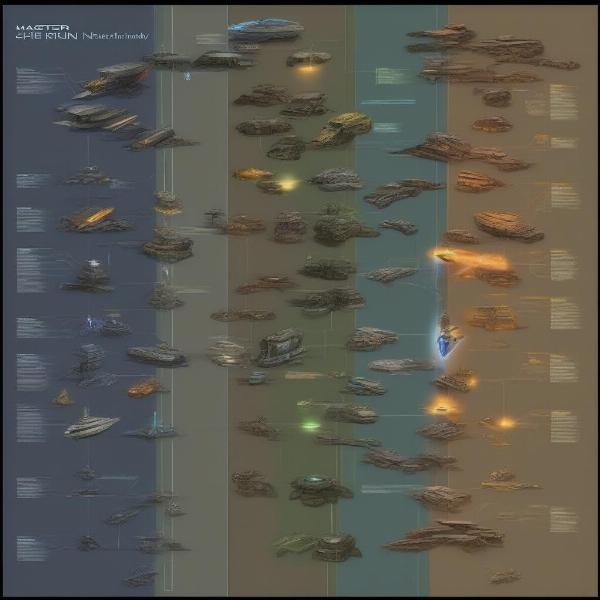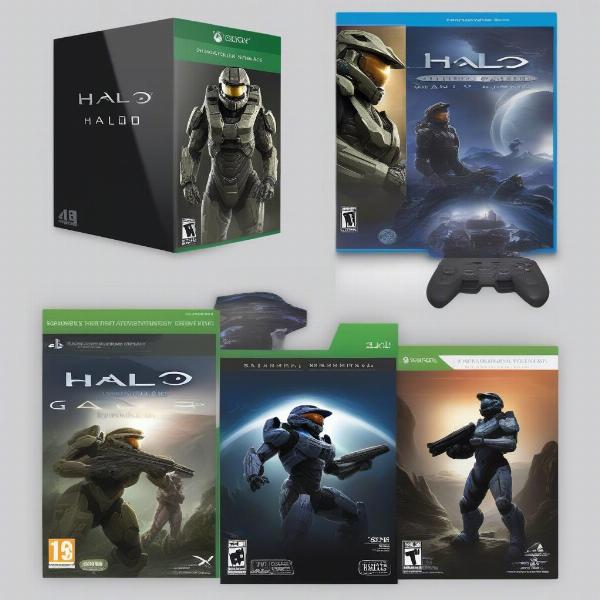Halo, the iconic first-person shooter franchise, has captivated gamers for over two decades with its engaging storylines, innovative gameplay, and memorable characters. Deciding the Best Order To Play Halo Games can be tricky for newcomers and even long-time fans looking to experience the saga in the most impactful way. Here at supremeduelist.blog, we understand the importance of a well-planned gaming journey, and we’re here to guide you through the chronological and release order options, highlighting the pros and cons of each.
This article will dive deep into the Halo universe, examining both the narrative and release-based play orders. We’ll break down each game, including spin-offs, providing insights into how they connect and contribute to the overall saga. By the end, you’ll be well-equipped to choose the perfect path to conquer the Halo universe.
Chronological Order: Diving Deep into the Lore
Playing Halo in chronological order offers a deep dive into the overarching story, allowing you to witness events as they unfold in the game’s timeline. This approach maximizes narrative coherence, providing a smoother understanding of character development and plot threads. Beginning with Halo Wars, then Halo Reach, allows you to appreciate the context of the conflict with the Covenant before diving into the Master Chief’s journey.
The Full Chronological List
Here is the full list of Halo games in chronological order:
- Halo Wars (2531): The story takes place before the events of the core series, showing us the early war against the Covenant.
- Halo Reach (2552): This prequel highlights the fall of the UNSC stronghold Reach and leads directly into the original Halo.
- Halo: Combat Evolved (2552): The saga begins with the introduction of Master Chief and the discovery of the first Halo ring.
- Halo 2 (2552): Expanding the story, Halo 2 offers perspectives of both the Chief and the Covenant forces through the Arbiter.
- Halo 3 (2552): Master Chief continues his fight with the Covenant on Earth, this leads to final confrontation with the Flood.
- Halo 3: ODST (2552): The campaign takes place during the events of Halo 2, showing another aspect of the conflict from the perspective of ODST soldiers.
- Halo Wars 2 (2558): This sequel returns to the RTS genre with new stories set after Halo 5, focusing on a new foe and the continuation of the UNSC vs. Banished war.
- Halo: Spartan Assault (2558): A top-down shooter focusing on the story of Spartan Sarah Palmer.
- Halo 4 (2557): After the war ends, we follow the Chief and Cortana to a new enemy and new challenges.
- Halo: Spartan Strike (2557): Another top-down shooter, this game explores the events of Halo 2 and expands on the lore.
- Halo 5: Guardians (2558): Master Chief goes AWOL and we follow Spartan Locke as they attempt to find the Chief.
- Halo Infinite (2560): The latest title takes place after the events of Halo 5, this game sees Master Chief battling a new enemy on another Halo ring.
 halo games chronological order showing master chief
halo games chronological order showing master chief
Benefits of Chronological Order
- Narrative Immersion: Experience the storyline as intended, with clear character arcs and plot evolution.
- Contextual Understanding: You will understand the events and characters introduced in later games, including the various factions and conflicts.
- Appreciation for Prequels: Halo Reach will be more impactful after understanding the broader conflict through Halo Wars.
Drawbacks of Chronological Order
- Gameplay Evolution: The change in gameplay from the earlier to later entries can sometimes be jarring. Playing Halo Wars first means switching to FPS for Halo Reach.
- Potential Spoilers: Playing games like Halo Wars or Halo Reach first, can reveal elements of the original Halo trilogy.
- Less Satisfying Pacing: The chronological approach might lose the magic of discovering the universe through the original release order.
“The chronological order provides a fantastic way to experience the Halo story in its intended timeline. However, it is important to understand that some gameplay experiences vary significantly from title to title, which might disrupt the flow for some players,” says Dr. Emily Carter, a game narrative specialist.
Release Order: The Original Experience
Playing the Halo games in the order they were released provides the experience that gamers had when each game launched. This method is an exploration of the series through the evolution of the game mechanics and the expanding of the Halo universe. This method also preserves the surprises and reveals as they were originally intended.
The Full Release Order List
Here’s the list of main games in order of release, for those wanting to follow the original path:
- Halo: Combat Evolved (2001): The title that started it all, establishing the core gameplay and lore.
- Halo 2 (2004): The sequel that expanded upon the universe with dual storylines and innovative gameplay elements.
- Halo 3 (2007): The conclusion of the original trilogy, featuring epic battles and a grand finale.
- Halo 3: ODST (2009): The first spin-off title with the perspective of the Orbital Drop Shock Troopers, this game provides an alternate viewpoint to events in Halo 2.
- Halo Reach (2010): This prequel, is one of the most beloved titles in the series that explains the events before Halo CE, focusing on the fall of Reach.
- Halo Combat Evolved Anniversary (2011): Remake of Halo CE with modern visuals and game features, also includes the campaign and multiplayer.
- Halo 4 (2012): The first game in the Reclaimer Saga, featuring a new art style and narrative focus.
- Halo: Spartan Assault (2013): Top-down shooter with new events and stories expanding the Halo universe.
- Halo: The Master Chief Collection (2014): This collection includes remasters of Halo 1-4 and was designed to allow new players to catch up with the series.
- Halo 5: Guardians (2015): Continuing the Reclaimer Saga with a controversial narrative.
- Halo Wars 2 (2017): The sequel to the original real-time strategy game that introduces a new story line and the banished threat.
- Halo: Spartan Strike (2015): The sequel to Spartan Assault, continuing the trend of top-down shooter Halo games.
- Halo Infinite (2021): The latest installment in the series, aiming to return to the core elements of the franchise with a new open-world setting.
 halo games release order showing various game covers
halo games release order showing various game covers
Benefits of Release Order
- Gameplay Progression: Witness the evolution of gameplay and graphics as the series developed.
- Surprise and Revelation: Experience the reveals and story twists as they were intended during the original release.
- Nostalgia: Relive the original experiences for long-time fans.
Drawbacks of Release Order
- Narrative Discontinuity: Playing out of chronological order can cause confusion with the storyline, with some gaps and flashbacks that become more confusing.
- Less Context: Some references and characters may be confusing without understanding the background from Halo Reach and Halo Wars.
- Outdated Mechanics: Moving from the more modern titles to older releases might feel clunky or lacking in features.
“Choosing to play in release order brings a strong sense of nostalgia and allows you to follow the development of the franchise from a gameplay perspective. However, some may find the narrative less straightforward compared to the chronological approach” explains Alex Nguyen, Lead Game Developer at a popular gaming studio.
Frequently Asked Questions about Halo Play Order
Does Halo Reach spoil Halo Combat Evolved?
- While Halo Reach is a prequel, it doesn’t heavily spoil Halo: Combat Evolved. It provides background information on the events leading to the start of Halo CE.
Is it ok to start with Halo Infinite?
- While Halo Infinite is accessible for newcomers, it may be less impactful without understanding the context from previous games. It’s recommended to have some familiarity with previous entries, especially Halo 4 and Halo 5.
Which order is best for first-time players?
- For first-time players, starting with the release order or with Halo: The Master Chief Collection is ideal. The collection provides a solid path through the main storyline and allows players to engage with the core games.
Should I play Halo ODST before or after Halo 3?
- The best time to play Halo 3: ODST is after Halo 3 because ODST is set during the events of Halo 2. The chronological place for ODST is after Halo 2.
Are Halo Wars games necessary to play?
- While the Halo Wars games are not essential to the main storyline, they enhance understanding of the broader universe and provide insights into the Covenant and UNSC conflicts.
Should I play the Spartan Assault and Spartan Strike spin-offs?
- The Halo Spartan titles offer additional lore and perspective on various events within the Halo universe, but they are not vital to the main storyline. These can be played at any point.
What is the Master Chief Collection?
- The Master Chief Collection is a package of remastered Halo games, including Halo: Combat Evolved Anniversary, Halo 2, Halo 3, and Halo 4. It is a great starting point for experiencing the main series.
How to play Halo on PC?
- Most Halo games, including Halo Infinite and the Master Chief Collection, are available on PC through Steam or the Microsoft Store.
Which Path Should You Choose?
The best order to play Halo games depends on your priorities. If you want a cohesive story and the most logical flow of events, the chronological order will be the most suitable for you. However, if you desire to experience the series as it was presented to players at launch with a sense of nostalgia, the release order would be your best choice. No matter the path, the Halo series will deliver one of the most memorable sci-fi adventures in video game history.
Here at supremeduelist.blog, we aim to help you make informed decisions about your gaming experiences. So, pick your path and get ready to embark on a legendary journey through the Halo universe. Let us know in the comments which order you chose and what your experience is like!
Leave a Reply